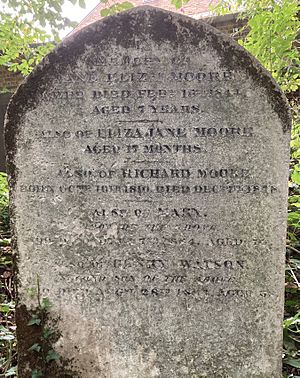Richard Moore (radical) facts for kids
Richard Moore (1810–1878) was an English politician who worked for important changes in his country. He was part of the Chartist movement, which aimed to give more rights to working people. He also played a big role in the fight against "taxes on knowledge", which made newspapers and books expensive.
Contents
Early Life and Beginnings in Politics
Richard Moore was born in London on October 16, 1810. He learned the skill of wood-carving and eventually started his own business, employing other people. Even when he was young, he became interested in politics and wanted to make things better for ordinary people.
In 1831, he joined a group called the National Political Union. This group worked to change voting laws. He also helped Robert Owen, who was a social reformer, with his projects.
Richard Moore and the Chartist Movement
The Chartist movement was a big effort in the 1800s to get more political rights for working-class people in Britain. They wanted things like the right for all men to vote.
In 1834, Moore led a group to meet with Lord Melbourne, who was the Prime Minister. They talked about the difficult lives of many people. In 1837, Moore helped create the "People's Charter". This was a list of six main demands for political reform. He represented the London Working-men's Association in this effort.
Moore was part of the National Convention in 1839, which worked to get the Charter passed. He also helped organize a welcome for two Chartist leaders, William Lovett and John Collins, when they were released from prison in 1840. He continued to work with Lovett in the Working-men's Association.
Moore believed strongly in the Chartist cause. However, he did not support using violence to achieve their goals. He always thought that the Charter would bring good changes, but he didn't promise it would solve every problem for working people. Later, he joined other groups like the People's International League and became the treasurer of the People's Charter Union in 1848.
Fighting for Fair Newspapers
After the main Chartist movement, Moore focused on a new important cause: getting rid of taxes on newspapers. These taxes were often called "taxes on knowledge" because they made it expensive for ordinary people to buy newspapers, books, and other printed materials. This meant it was harder for them to get information and learn.
Moore worked hard to convince politicians like Richard Cobden to support this idea. He believed that removing these taxes would help connect working-class and middle-class people over financial reforms.
The People's Charter Union created a committee to fight these taxes, called the National Stamp Abolition Committee (NSAC). This committee often met at Moore's house, and he became its permanent chairman. From 1849 until 1861, when the tax on paper was finally removed, Moore attended 390 meetings related to this campaign! He worked with other important radicals like Henry Hetherington and James Watson.
After two years, the NSAC joined with a larger group called the Association for Promoting the Repeal of Taxes on Knowledge (APRTK). Moore was one of its most active members, helping to organize many events with Collet Dobson Collet. The APRTK had important leaders, including Thomas Milner Gibson as President and Moore as Chairman. This group included many middle-class reformers, like John Bright.
The APRTK continued to campaign, even working on postal rates to make it cheaper to send newspapers. The last meeting of this group took place at Moore's house in 1870.
Later Life and Legacy
Richard Moore was also a member of many other groups, including the Society of the Friends of Italy and the Jamaica Committee. He worked to make elections fair in his local area of Finsbury, where he had lived since 1832. He also helped manage the Sunday band in Regent's Park.
Richard Moore died on December 7, 1878. He was buried in the western part of Highgate Cemetery.
Family
On December 9, 1836, Richard Moore married Mary Sharp from Malton, North Yorkshire. She was the niece of James Watson, who was a publisher and also a Chartist. Mary and four of their children were still alive when Richard Moore passed away.


